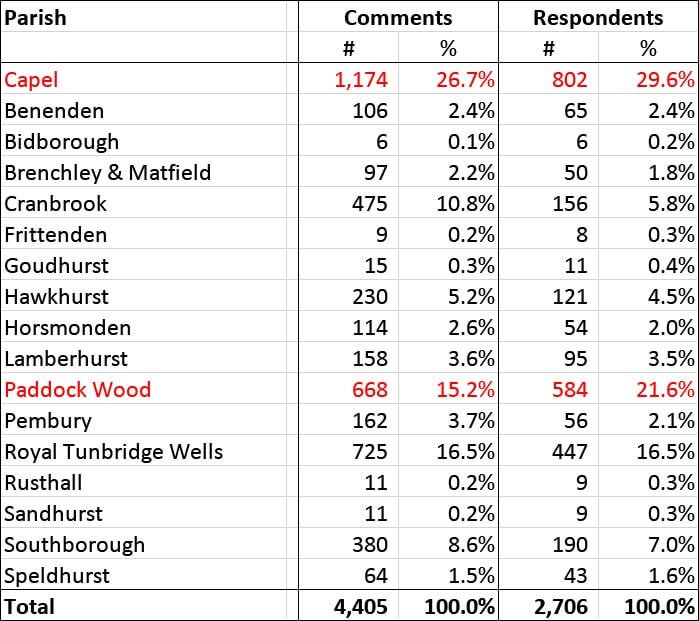Tunbridge Wells Borough Council has recently postponed the development of the Local Plan by six months. When explaining the delay, Council Leader McDermott declared that “it is evident from… the comments received that further work is needed in relation to a broad range of matters”. This can safely be described as a considerable understatement!
At Save Capel, we decided to delve into the Regulation 18 commentary to gain a true picture of the response to TWBC’s draft Plan. The findings are clear and compelling – and paint a much more vivid picture of why there is a delay: The plans for Capel attracted a very strong response and were overwhelmingly rejected!
Read more below.
What did we analyse?
Our goal was to truly understand the community’s response to the Local Plan, especially with regard to the proposals for Capel Parish.
We focused our analysis on Section 5 (“Place Shaping Policies”) of the Local Plan:
- This is the only part of the Plan specific to geographic location and includes the feedback on all sites / development proposals for the entire borough, including Capel.
- With more than 4,400 comments, Section 5 also provoked by far the highest number of responses. In fact, the section received more comments than all other sections combined (ca. 51% of the total).
Sadly, TWBC did not make our job easy. We faced two hurdles when evaluating the responses:
- Disaggregated responses: TWBC’s planning team often split up individual responses into separate comments allocated to different sections of the Plan. At times, this made it difficult to gauge an individual’s response since the commentary was out of context.
- Lack of transparency: There is a complete absence of any analysis or summary on the aggregate support for the Plan. And there is a similar lack of transparency at the level of individual comments. TWBC only explicitly calls out the respondent’s position on the Plan (e.g. “Support” or “Object”) for a sub-set of responses. Mostly, this is simply missing – even though it is often explicitly stated in the response (or can be easily deduced). This means that the only way to gain a true picture of the community response is to review thousands of comments one-by-one. And in Capel’s case this lack of transparency obscures an absolutely overwhelming opposition to the Plan.
As a result, we went through all responses one-by-one, reviewed the commentary and assigned a point of view on the Plan: ‘Object‘ vs. ’Support’. In most cases, respondents’ opinions were explicit and easy to understand – if not, we captured this under ‘Other’ (neutral / general observation).
So, what did we find?
Finding 1: We care a lot (about Capel)!
The Capel section of the Plan received an incredible 1,174 comments from 802 unique respondents. This is by far the largest amount of comments for any parish in the borough. It is equivalent to 27% of all comments received and 30% of all respondents across the entire borough (42% and 51% if combining Capel & Paddock Wood). No other parish apart from Paddock Wood (584) and Tunbridge Wells (447) even breached 200 respondents. And note that in these numbers the Save Capel petition – signed by over 3,750 people – was only counted as one response!
A massive thank you to all of our supporters!

Table 1 – Response to the Plan by Parish (section 5 only)
Finding 2: Plans for Capel are overwhelmingly rejected
The rejection of plans for Capel Parish are near unanimous: 92% of the 1,174 comments on Capel firmly reject the plans (6% are neutral, 2% are supportive). When looking at the 802 individual respondents the feedback is even more one-sided: 97% of respondents ’object’ to the plan, 2% ’support’, 1% are ’general observations’. NINETY-SEVEN PERCENT!
It is extremely rare to get such an unambiguous result in a democratic process. Maybe, just maybe, could this be an indication that the plan for Capel is a bad idea?

Graph 2 – Response to the Plans for Capel (Object vs Support vs Neutral)
Finding 3: Opposition to Capel Plans is widespread
Interestingly, the opposition to the plans for Capel is not limited to local residents but is distributed within and outside of TW borough. As you would expect, a large portion of respondents (~40%) are from Capel Parish itself. But nearly half of our support comes from outside the borough – ca. 40% of respondents are from Tonbridge and 10% are from Golden Green/Hadlow/East Peckham. The remaining 10% of respondents are from other parishes across the borough of Tunbridge Wells.
This cross-boundary interest is heartening and very welcome, but it is a sad state of affairs when it takes ’non-borough residents’ to remind TWBC of the need to be a good neighbour, and to highlight how non-sensical these plans really are.
Finding 4: What’s wrong? Take your pick
When perusing the reasons for objecting to the plan, the list is long and varied. Environmental concerns top the list – the destruction of 600 acres of green belt, climate change, air, noise and light pollution. Followed by lack of transportation and infrastructure. Flood risk. Loss of high quality farmland. Damage to the rural landscape and our heritage. Loss of biodiversity. Concerns on due process and delivery risk. Impact on a neighbouring borough. Not to mention the complete disregard for the needs of the local residents whose livelihoods will be turned upside down and whose parish will be unrecognisable.
Finding 5: Respondents – The good, the not so good and the ugly
Beyond individual responses, the plan also attracted commentary from a wide array of political bodies, special interest groups and developers. Though their responses were not always as expected.
Our allies
Reassuringly, Save Capel can count on a wide range of potential allies: The plan was opposed by or at least caused strong concern with 10 political representatives including Tom Tugendhat (MP for Tonbridge & Malling), Tonbridge & Malling Borough Council, the parish councils of Capel, Brenchley & Matfield, East Peckham, Hadlow, Shipbourne and various councillors. We also attracted support from many interest groups such as the CPRE, High Weald AONB Unit, Tonbridge Line Commuters, TW Friends of the Earth and the Tonbridge Civic Society. Our heartfelt thanks go to everyone that voiced their opposition!
Rather more surprising is the fact that there are also four developers objecting to the Capel plans. Dandara/ DHA Planning, Persimmon, Sigma / Rydon and Taylor Wimpey all objected – typically on the basis of excessive cost, unrealistic timelines and unnecessary risk. While they will all have their own axe to grind, should the fact that developers are declaring Capel plans unrealistic not give pause for thought?
The timid list
Less impressively, there are a number of organisations that are rightfully concerned but did not declare an objection. Were they too timid? This includes a number of public bodies such as Capel United Church, Highways England, Historic England, Natural England, NHS West and the RSPB. All of the above neither supported nor objected to the plans but restricted themselves to raising concerns or making general observations.
Our message to you…. we respect your desire to be balanced, inclusive or non-confrontational, but when plans are this poor it is okay to object.
Those motivated to support
And finally, to the 13 respondents who actively supported the plans for Capel:
Unsurprisingly, this includes six developers or agents with proposed developments in Capel (Hadlow/Turnberry, Crest Nicholson/Barton Willmore, Tesco/Martin Robeson, Dandara/CBRE, Millwood/Woolf Bond Planning and Bellway Homes/Turley), as well as two public bodies (Kent County Council and Southern Water).
Rather more bizarre is the support of the British Horse Society and Sport England. Really?
But, we are especially saddened by the response of our neighbours in the Hawkenbury Village Association, who called on their residents to actively support the Capel plans in order to shift development away from Hawkenbury. Thankfully, hardly anybody listened, and hopefully that Association’s response will be more considered and less self-centred in the next phase of the Local Plan.
What does it all mean?
The community has spoken
First and foremost – the community’s opposition to the Local Plan is very clear. And however much this is sugar-coated, the overwhelming response is at least part of the reason for the delay to the Plan. Though whether TWBC will use this time productively and revert with a plan that we can all wholeheartedly support – or persist in their misguided attempts to destroy the green belt – only time will tell.
Hope for the best – prepare for the worst
While the loud echo that Save Capel’s campaign has had in the community is gratifying to hear, it would be naïve to assume that our opponents will just give up and go home. There simply is too much easy money to be made by de-classifying and building over the green belt. We should expect TWBC and the developers to continue to pursue their plans going forward. At Save Capel we are re-mobilising to meet the challenge.
What about brownfield?
One thing that will not have changed is that TWBC is under pressure to build thousands of new houses. At Save Capel, we understand and support this principle (though not the amount of houses targeted). Indeed, one of our aims is to help TWBC by presenting them with workable alternatives that prioritise brownfield and urban regeneration instead of destroying the countryside that gives the Garden of England its name. This will be one of our key priorities going forward.
In for the long haul
To close on a personal note – while the numbers above clearly reflect the balance of opinion, they do not quite convey the strength of feeling in the community. For that you need to read the 1,200 odd responses related to Capel where the confusion, exasperation and sheer anger is palpable and leaps off the page.
On behalf of the Save Capel Executive: There can be no stronger motivation and we are committed to continue our campaign to protect the Green Belt and stop these mindless plans during Regulation 19 and beyond.
What does TWBC have to say?
After compiling our findings, we presented them to Stephen Baughen, Head of Planning at Tunbridge Wells Borough Council. His response was as follows: “The Borough Council is carefully considering all comments received, which is the main reason for needing more time to progress the Local Plan to the next stage. The programme, including the anticipated timing of further publicity, is set out in the Local Development Scheme, which is on the TWBC website.
“At this point, I would just comment that the disaggregation of responses has been done where respondents make points in relation to different parts of the Local Plan, to make sure these are considered alongside other related comments. To not have disaggregated responses as such would mean that it would be very difficult for an interested party to understand all comments made on that particular part of the Local Plan, without reviewing all responses sent.
“The comments are presented without any analysis or summary, to be open and read as they are.
There is no doubt that the responses raise a wide range of issues, which the Council is currently considering.”
We find it interesting, but not entirely surprising, that Stephen only commented on the technical aspects of our findings and not the wide-ranging call for the plans in Capel to be dropped.
We wait in anticipation to discover how the council responds but rest assured our relentless focus on halting the plans will continue until we do.


